Organofunctional silanes are bi-functional molecules in that they usually have two types of reactivity built into their structures -organic and inorganic.

Monomeric silicon chemicals are known as silanes. A silane that contains at least one silicon carbon bond (e.g., Si-CH3) is an organosilane. The carbon-silicon bond is very stable and none polar, and in the presence of an alkyl group it gives rise to low surface energy and hydrophobic effects.
Organofunctional silanes are molecules carrying two different reactive groups on their silicon atom so that they can react and couple with very different materials (e.g., inorganic surfaces and organic resins via covalent bonds and often via a polymeric “transition” layer between these different materials).
The value of organofunctional silanes as coupling agents was discovered in the 1940s, during the development of fiberglass-reinforced composites. When initially fabricated, these new composites were very strong, but their strength declined rapidly during aging underwater. This weakening was caused by a loss of bond strength between the glass fibers and the resin. Researchers found that certain organofunctional silanes prevented ingress of water and bond displacements at the fiber/resin interface but also significantly increased the composite initial strength.
At 1950, the Chinese Academy of Sciences (ICCAS) developed several α-silane like 3-Aminopropyltriethoxysilane (CAS# 919-30-2), 3-Glycidoxypropyltrimethoxysilane (CAS# 2530-83-8), 3-Methacryloxypropyltrimethoxysilane (CAS# 2530-85-0), 3-Mercaptopropyltrimethoxysilane (CAS# 4420-74-0); and at 1954 Professor Zhou Qingli of Nanjing University synthesized a series of γ-silane. After that the commercial production of organofunctional silane in China has been begun. With 60 years development Chinese organofunctional silane industry has been a competitive industry in the global market, with the mature upstream and downstream system, advanced technology and rich experience, we can supply a good product at a good price.
Now organofunctional silane has a wide application at the resin based composites or coating applications such as coating, paint, ink, adhesive, sealant, rubber, tire, plastic, cable, pipe, building protection, filler, pigment, glass fiber and mineral/glass wool insulation. It is versatile and can used as coupling agent, adhesion promoter, crosslinking agent, dispersion aid, water repellent, water scavenger, more application is still under development.
1. General Silane Structures
The general formula of a CapatueTM organofunctional silane shows 4 classes of moieties attached to the silicon atom:
Y-R-Si-Men(OR)3-n n = 0 or 1
Y group represents the none-hydrolysable organic moiety that can be either an alkyl, organofunctional (like amino, epoxy, sulfur, mercapto, acryl, vinyl, ureido, isocyanato group), aromatic, or a combination of any of these groups. These groups provide the organic compatibility which allows the organofunctional silane to form the interpenetrating polymer networks, or in the case of reactive organofunctional silanes, to co-react with the various polymers. The end users should select the suitable CapatueTM organofunctional silane according to the polymers’ type, we offer our knowledge, experiences & know-how in this field to share with our customers as SELECTION GUIDE.
R group represents the linking chain like C3H6 or CH2 and it is chosen for synthetic convenience and resin compatibility. When R is C3H6 group we always called it as γsilane as its Y group is at theγposition. Most commercialized organofunctional silanes areγsilanes. When R is CH2 group it is α silane, it is more active owing to their α-effective.
Me group represents methyl group which will further slow the hydrolysis reactions, trialkoxy silanes don't have this group.
OR group represents alkoxy moieties, most typically methoxy or ethoxy, and bulkier X groups will be slower to hydrolyze. It will react with the various forms of hydroxyl groups and liberate methanol or ethanol. These groups can provide the linkage with inorganic substrates, pigment, or filler to improve compounds and composites integrity and adhesion. The alkoxy groups are also capable of reacting with hydroxy functional polymers.
2. Dual-Functional Molecules & Dual Reactivity
⑴ Step 1: Group Y bonds or interacts with a polymer or organic surface.
⑵ Step 2: Group OR after hydrolysis bonds or interacts with metal, glass, inorganic or hydroxylated organic surface (adhesion)
And/or …
Group OR after hydrolysis reacts with othe r silane-modified polymers (crosslinking).
3. Graphical Representation
⑴ Reaction of Silanes with Surfaces
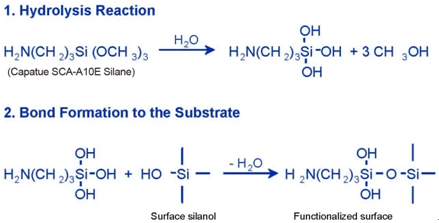
⑵ Silane as Coupling Agent and Adhesion Promoter
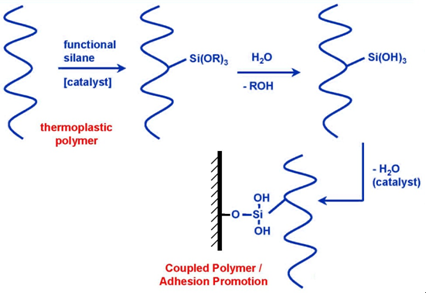
⑶ Silane as Crosslinking Agent
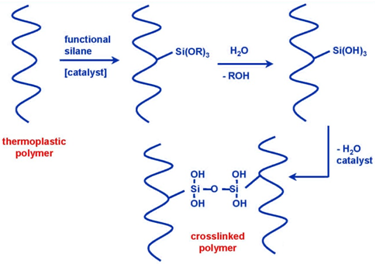
⑷ Silane as Primer
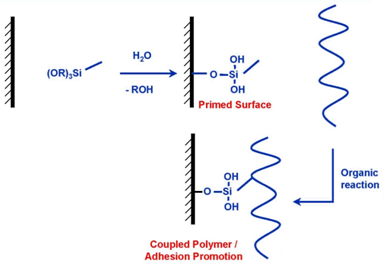
CapatueTM organofunctional silanes are used to provide a stable bonding between two otherwise nonbonding and incompatible surfaces. In reinforced and filled plastics, the improved bonding between the fibrous or particulate inorganic component and the organic matrix polymer results in greater composite strength and longer service life.
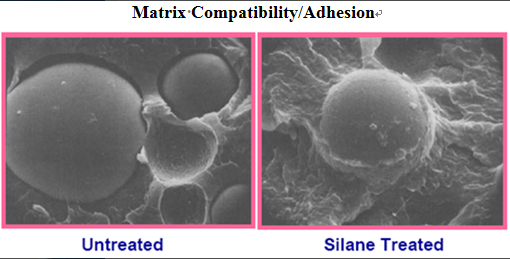
Meanwhile CapatueTM organofunctional silanes are extremely versatile products that can react with a wide variety of organic and inorganic materials. Their unique ability as coupling agents, corsslinking agents, surface modifiers, adhesion promoter, dispersion aid, surface modifier, water scavenger, monomer for copolymerization and end-capper have been proven in an ever-increasing number of applications, ranging from adhesives, coatings, plastic, rubber, composite, amino silicone oil to foundry binder resins.
The benefits that CapatueTM silanes can impart to these end-use applications are highlighted as below for your brief information.
Applications
Benefits
Adhesive & Sealant
Moisture initiated corsslinking of resins, improved wet
adhesion, chemical and corrosion resistance, filler
dispersion, weatherability, rheology and filler/resin
coupling.
Coating, Paint & Ink
Moisture initiated corsslinking of resins, improved wet
adhesion, chemical and corrosion resistance,
weatherability, pigment dispersion and scrub resistance,
release and wetting.
Glass Fiber & Batt
Coupling of resins with fiber for improved resiliency of
insulation batts, better wet strength retention and
electrical properties of FRP composites, and improved
fiber strand integrity, protection and handling.
Mineral Filler & Pigment
Improved coupling of resins with fillers, better filler
dispersion and processing ease-in thermoset and
thermoplastic resins.
Foundry
Coupling of resins with sand for improved foundry core
strength.
Polymer Modification
Moisture-cure crosslinking to give improved
environmental and chemical resistance.
Rubber & Elastomer
Coupling of resins with minerals for improved composites
strength, toughness, abrasion resistance, rolling
resistance, wet electrical properties and rheology
control.
Textile
Altered textile hand and water repellency, and improved
dye receptivity.
Thermoplastic
Mineral and pigment treatment for dispersibility and
coupling, coupling of resins with fillers in high
performance thermoplastics and moisture curable
crosslinking polyethylene for wire & cable and pipe.
Organofunctional silane is a versatile additive for too many different applications including plastic, rubber, coating, adhesive, composite, filler treatment and so on, thus its using method is also diverse depends on the applications & equipment conditions.
1. Using as an additive in coating-like formula: for coating, paint, ink, adhesive, sealant and other liquid formula, add organofunctional silane could added in the resin or hardener directly at about 0.3~2.0% rate. 1% is always a common dosage, and stirring is always to required for a homogeneous dispersion. The reactivity and compatibility of the organofunctional silane in the resin or hardener should be considered and observed, for example amino silane like SCA-A10E could react with epoxy resin, thus it should not be added in the epoxy part but in the amine hardener part for a 2 part epoxy resin coating or sealant. As organofunctional silane could hydrolyze to form gel and to lose its function when water exist in the resin, solvent, filler, pigment, thus for a long shelf life some water scavenger should be added together with organofunctional silane.
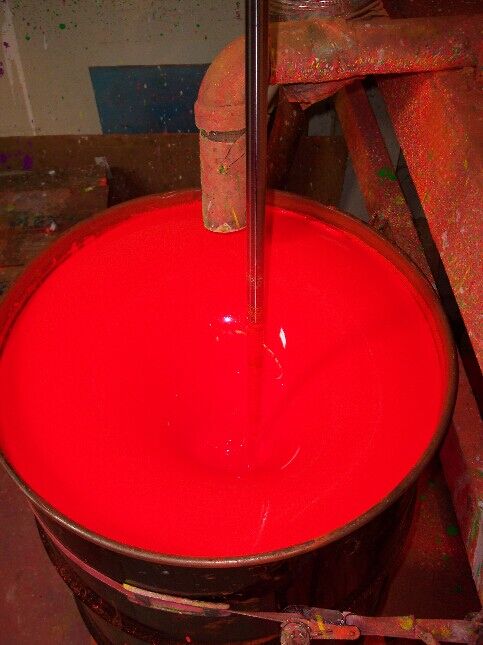
2. Deposition from aqueous alcohol solutions is the most facile method for preparing silylated surfaces. A 95% ethanol / 5% water solution is adjusted to pH 4.5~5.5 with acetic acid. Silane is added with stirring to yield a 2% final concentration. Five minutes should be allowed for hydrolysis and silanol formation. Large objects, e.g. glass plates, are dipped into the solution, agitated gently, and removed after 1~2 minutes. They are rinsed free of excess materials by dipping briefly in ethanol. Particles, e.g. fillers and supports, are silylated by stirring them in solution for 2~3 minutes and then decanting the solution. The particles are usually rinsed twice briefly with ethanol. Cure of the silane layer is for 5~10 minutes at 110°C or 24 hours at room temperature (60% relative humidity).
For aminofunctional silanes such as SCA-A10E and SCA-A20M this procedure is modified by omitting the addition of acetic acid. The procedure is not acceptable for chlorosilanes as bulk polymerization often occurs. Silane concentration of 2% is a starting point. It usually results in deposition of trialkoxysilanes as 3~8 molecular layers. Monoalkoxysilanes are always deposited as monolayers or incomplete monolayers. Caution must be exercised if oven curing. Exhausted, explosion-proof ovens must always be used.
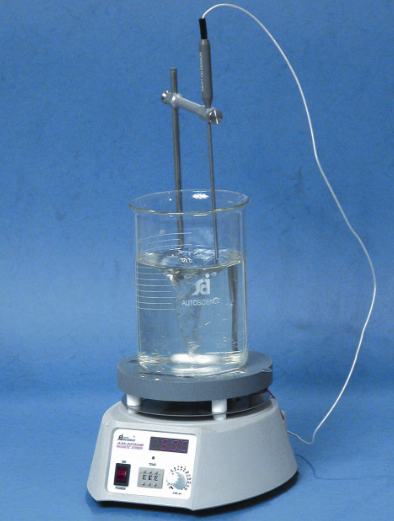
3. Deposition from aqueous solution is employed for most commercial fiberglass systems. The alkoxysilane is dissolved at 0.5~2.0% concentration in water. For less soluble silanes, 0.1% of a non-ionic surfactant is added prior to the organofunctional silane and an emulsion rather than a solution is prepared. If the silane does not contain an amine group the solution is adjusted to pH 5.5 with acetic acid. The solution is either sprayed onto the substrate or employed as a bath dip. Cure is at 110~120°C for 20~30 minutes.
Stability of aqueous silane solutions varies from hours for the simple alkyl silanes to weeks for the aminosilanes. Poor solubility parameters limit the use of long chain alkyl and aromatic silanes by this method. Distilled water is not necessary, but water containing fluoride ions must be avoided.
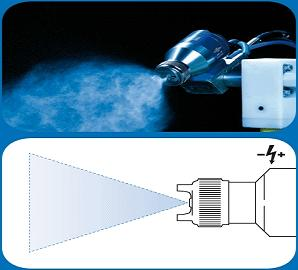
4. Bulk deposition onto powders, e.g. filler, pigment treatment, is usually accomplished by a spray-on method. It assumes that the total amount of silane necessary is known and that sufficient adsorbed moisture is present on the filler to cause hydrolysis of the silane. The silane is prepared as a 50~ 25% solution in alcohol, in some application pure organofunctional silane could be used directly. The powder is placed in a high intensity solid mixer, e.g. twin cone mixer with intensifier. The solution is pumped into the agitated powder as a fine spray. In general this operation is completed within 20 minutes. Dynamic drying methods are most effective. If the filler is dried in trays, care must be taken to avoid wicking or skinning of the top layer of treated material by adjusting heat and air flow.
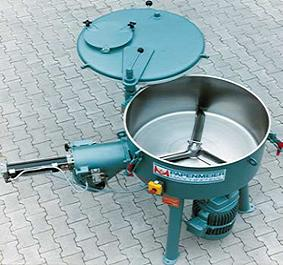
5. Integral blend methods are used in composite formulations. In this method the organofunctional silane is used as a simple additive. Composites can be prepared by the addition of alkoxysilanes or silazanes to dry-blends of polymer and filler prior to compounding. Generally 0.2 to 1.0 weight percent of silane (of the total mix) is dispersed by spraying the silane in an alcohol carrier onto a pre-blend.
The addition of the silane to the non-dispersed filler is not desirable in this technique since it can lead to agglomeration. The mix is dry-blended briefly and then melt compounded. Vacuum devolatization of by-products of silane reaction during melt compounding is necessary to achieve optimal properties. Properties are sometimes enhanced by adding 0.5~1.0% of tetrabutyl titanate or benzyldimethylamine to the silane prior to dispersal.
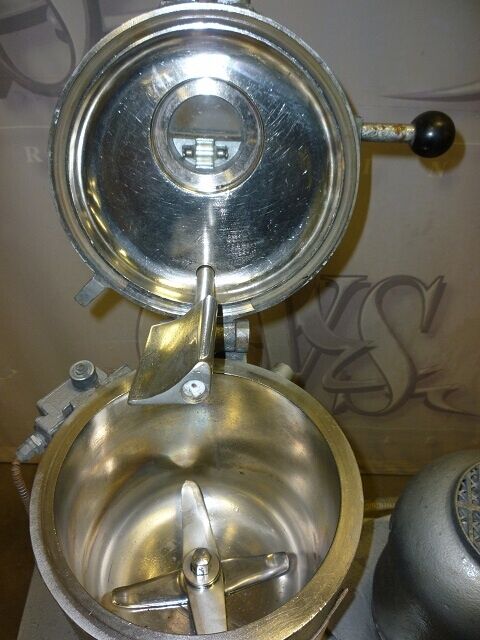
6. Deposition as a primer is employed where a bulk phase is required as a transition between a substrate and a final coating. The silane is dissolved at 50% concentration in alcohol. One to three molar equivalents of water are added. The mixture is allowed to equilibrate for 15~20 minutes. then diluted to 10% concentration with a higher boiling point solvent. Materials to be coated with the primer are dipped or sprayed and then cured at 110~120°C for 30~45 minutes.
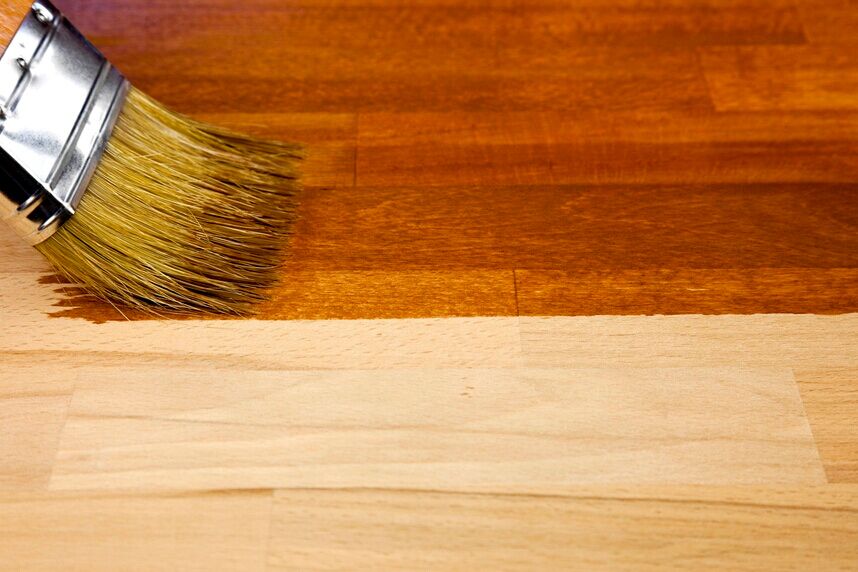
APPENDIX
Calculation of necessary silane to obtain minimum uniform multilayer coverage can be obtained knowing the values of the specific wetting surface of silane (ws) and the surface area of the filler.
amt. of silane (g) = amount of filler x surface area of filler
specific wetting surface
The relative surface area of some common fillers are as below for the reference, the end user could get the precise value from their filler supplier. (unit: m2/g)
E-glass
0.1~0.12
Talc
7
Silica, ground
1~2
Si, diatomaceous
1~3.5
Kaolin
7
Calcium silicate
2.6
Clay
7
Silica, fumed
150~200
1. Polymer reactivity & matching
The choice of a CapatueTM organofunctional silane is specific to the resin type and application. We recommend that you contact us for assistance before selecting a silane for your end-use application. The following selection guide is provided to help you select the appropriate organofunctional silane for various polymer (resin) systems. It should be considered merely a starting point. The selection of the preferred silane for a specific end-use application may require specific experimentation.
Polymer
Organofunctional Silane
Amino
Epoxy
Sulfur
Mercapto
Acryl
Vinyl
Ureido
Isocyanato
Epoxy
☆
☆
◇
Phenolic
☆
◇
☆
Urea-formaldehyde
◇
◇
☆
Melamine
☆
◇
◇
Furan
☆
◇
Polyester
□
□
Unsaturated PET
☆
◇
Vinylite
◇
☆
Polyurethane
☆
☆
☆
◇
☆
PU Dispersion
◇
□
Acrylic
☆
☆
◇
◇
◇
Acrylic Latex
□
◇
☆
☆
UV Resin
□
☆
☆
Polysiloxane
☆
☆
◇
☆
Sulfur Cured Rubber
☆
☆
PO Cured Rubber
☆
☆
Polysulfide
□
☆
☆
☆
SBR Latex
□
◇
◇
Cellulose
◇
□
◇
Nitro-cellulose
◇
Polyether
□
☆
Polyvinyl butyral
□
☆
Polyamide
☆
☆
◇
☆
EVA
☆
◇
☆
Polyolefin
□
◇
☆
☆
Notice: ☆——Generally effective ◇——Alternate □——Only effective with specific grades
2. Substrate or filler reactivity & matching
Organofunctional silane is not suitable for all kinds of substrates or fillers, but only for those active surface which have some active hydroxyl groups on it. The following table summarizes the organofunctional silane reactivity and effectiveness for the regular substrates/fillers:
Silane Effectiveness
Substrate/Filler
Excellent
Silica
Quartz
Glass
Aluminum
Copper
Alumino-Silicate
Good
Mica
Talc
Inorganic Oxides (e.g. Fe2O3, TiO3, Cr2O3)
Steel
Iron
Asbestos
Nickel
Zinc
Lead
Moderate
Gypsum (CaSO4)
Barytes (BaSO4)
Poor
Chalk (CaCO3)
Graphite
Carbon Black





